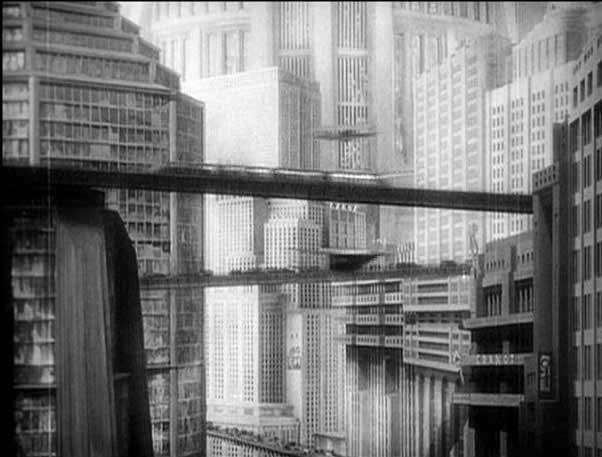 |
| Fig 1. |
These ideological quirks carry over into the art direction which is herein used in such a way as to characterise the environment; above ground scenes feature buildings hewn from stark lines and horrible almost parasitical machines slaved over by a faceless mob of workers that puts forth a sense of technological fetishism and raises questions of the relationship man has with machine, indeed "The tasks assumed by the workers are purely mechanical, needing absolutely no brain power, making them nothing more than an extension of the machine." (Citizen, 2010) . The frenetic energy present in both the editing and design creates an almost nightmarish hubbub which brings forth an interesting disparity with the serenity of the underground church where the workers go to listen to Maria, the almost de facto leader of their congregation, the dichotomy suggested within this small space is extremely important in that it parries the nightmare above with religious imagery of crosses and a myriad of organic shapes to suggest something old, and certainly before Metropolis' time, but also something holy that has only just been discovered and is therefore precious to these characters. That thought is promoted. purely by that important contrast suggested in the artistic choices alone.
Fritz Lang's "Metropolis" (1927) stands as the proud forerunner of grand dystopian science fiction as it is "Generally considered the first great science-fiction film" (Ebert, 1998) Be that from its adoption of utopian principles and visuals that ultimately give way to something more sinister, it's riffs on anti establishment ways of thinking or only for it's now tried and tested display of what a broken futuristic society looks like. This film is so ingrained and so important to science fiction today that "Metropolis" could be used as a kind of checklist against more contemporary offerings to glean certain archetypes that have carried over the years. Metropolis has it all, the failed creator; battered and broken by past tragedy, the original mad inventor, a bright new future seen in the young, shady intelligence people keeping Orwellian like tabs on particular characters. Ridley Scott certainly owes a lot to "Metropolis" whether he'd care to admit or not.
 |
| Fig 2. |
Everywhere the viewer can see, something is happening, something that helps with the scale, and enables the viewer's suspension of belief if only for a few fleeting moments. "Metropolis" is a palpable, visceral and real piece that is often diluted into lesser experiences without transference or special emphasis placed on the themes and ideas that make the original so iconic.
 |
| Fig 3. |
Bibliography
Ebert, Roger. 'Metropolis Movie Review & Film Summary (1927) | Roger Ebert'. Rogerebert.com. N.p., 1998. Web. 29 Sept. 2015.
Glancey, Jonathan. 'From Metropolis To Blade Runner: Architecture That Stole The Show'. the Guardian. N.p., 2009. Web. 29 Sept. 2015.
Vigilantcitizen.com,. 'The Occult Symbolism Of Movie "Metropolis" And It's Importance In Pop Culture'. N.p., 2010. Web. 29 Sept. 2015.
Figure 1. Metropolis (1927) [Poster] At: https://hypergrid.org/metropolis/wiki/en/images/f/f9/Metro_001.jpg (Accessed on 29.09.2015)
Ebert, Roger. 'Metropolis Movie Review & Film Summary (1927) | Roger Ebert'. Rogerebert.com. N.p., 1998. Web. 29 Sept. 2015.
Glancey, Jonathan. 'From Metropolis To Blade Runner: Architecture That Stole The Show'. the Guardian. N.p., 2009. Web. 29 Sept. 2015.
Vigilantcitizen.com,. 'The Occult Symbolism Of Movie "Metropolis" And It's Importance In Pop Culture'. N.p., 2010. Web. 29 Sept. 2015.
Illustrations
Figure 2. Metropolis (1927) [Still] At: http://www.tboake.com/dystopia/patterson/images/METROPOLIS_USA_NTSC-120.jpg (Accessed on 29.09.2015)
Figure 3. Metropolis (1927) [Still] At: https://blogger.googleusercontent.com/img/b/R29vZ2xl/AVvXsEh4nx_hUa6qVPXrR0S5HSy-VyHPv7F2uMviJOPT2jLFCiQDS2MmVcrITwXWWS8CwN-sp1Ivjo2anPeNrNR3QBbwXpxD1syUNamvEjefSwaQSYMSSiXmrIw5qP-r1LOfhHCGa82crSGU5ZY/s1600/Metropolis_041Pyxurz.jpg (Accessed on 29.09.2015)

'...horrible almost parasitical machines slaved over by a faceless mob of workers that puts forth a sense of technological fetishism and raises questions of the relationship man has with machine.' - a very thoughtfully written review :)
ReplyDeleteAlmost there with the referencing - you need to also include the web address in the bibliography, and certain parts need to be italicised - see here again - http://community.ucreative.ac.uk/Harvard-Referencing